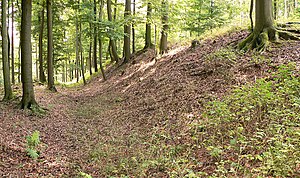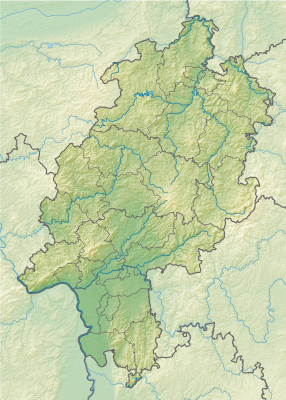Altenburg (Niederurff)
| Altenburg | ||
|---|---|---|
|
4 meter high outer wall in the south |
||
| Alternative name (s): | Altenburg near Römersberg, ring wall Altenburg near Niederurff | |
| Creation time : | Iron age | |
| Castle type : | Hilltop settlement | |
| Conservation status: | ruin | |
| Place: | Neuental | |
| Geographical location | 51 ° 2 '39.2 " N , 9 ° 12' 44.7" E | |
| Height: | 432.7 m above sea level NHN | |
|
|
||
The Altenburg bei Niederurff (also Altenburg bei Römersberg ) is a larger Iron Age fortification on the summit of the 432.7 meter high mountain Altenburg in the Hessian Schwalm-Eder district on the boundary between Niederurff , part of the municipality of Bad Zwesten , and Arnsbach (Borken) , District of Borken to the southeast of the district of Römersberg , district of Neuental . The complex is one of the best preserved Iron Age ring walls in northern Hesse .
From 1984 individual Neolithic finds in the southern wall area came to light. However, the focus of settlement was the Iron Age: The mountain was settled in the older and younger pre-Roman Iron Age and was fortified in the younger Iron Age at the latest .
description
The ring wall system and fortified hillside settlement was created around the summit. It covers a total area of around 8.3 hectares and is surrounded by a total of three defensive rings with ramparts that are up to 4 meters high today. There are no stone remains from the earlier settlement, as the buildings were probably built from wood, straw and clay.
The outer fortification line consists of a wall that borders an approximately 500 × 200 meter large irregular rectangle. A wall was not required on the steep west and east flanks and the embankments were steepened instead. In the flat areas there is a ditch in front of it. The excavation in 1984 revealed that the wall in the southern area was built as a wall in the form of wood / earthwork.
The middle line of fortifications is only in the south as a wall in slightly sloping terrain. There the plateau secured by the wall was used as settlement area. The effect of the ramparts was reinforced by artificially steepening the slopes, creating 12-meter-high embankments. This made it possible to defend the former main access route from the south.
The wall of the inner fortification, which is still 2 meters high today, is triangular in shape and covers an area of around 1.5 hectares. It has gate openings in the south and northeast. In the flat terrain there were trenches in front of the wall, on the steep slope sides palisades were presumably used for security.
The vital water supply took place in prehistoric times from several sources, which have now dried up or only carry a little water in above-average humid years. Their importance is evident from the fact that some of them were integrated into the wall system at great expense (annex source, slope source, wall source).
excavation
During the construction of the observation tower on the summit of the Altenburg mountain in 1963, numerous ceramic shards were found. Similar accidental finds had been made on the mountain before. In 1984 an archaeological excavation was carried out by the State Office for Monument Preservation in Hesse . Numerous finds from the middle La Tène period were made, including weapons, ceramics, tools and harness .
A presumed cult or sacrificial site was also discovered where, in addition to numerous ceramic shards, 77 iron objects were found. The objects that have been deliberately rendered unusable, such as swords, lance heads and arrowheads, testify to their character as cult or ritual objects.
Multiple robbery excavations have caused some destruction of finds. The complex is a designated ground monument according to the Hessian Monument Protection Act . Investigations and targeted collection of finds are subject to approval, and accidental finds are reported to the monument authorities.
Historical classification
The archivist and historian Georg Landau identified the Altenburg ramparts as a site from the Iron Age as early as the middle of the 19th century .
The earliest traces of human presence on the Altenburg mountain have been documented as early as the Neolithic Michelsberg culture (5500 to 4900 BC) (e.g. through stone ax finds). A permanent settlement already at this time seems unlikely. It was not until the beginning of the Hallstatt period , around 750 BC. BC (Hallstatt C), the mountain was visited more often, settled for a longer period of time and probably already fortified. Several cultural phases up to the middle La Tène period, around 150 BC, can be traced back to the archaeological finds that can be dated. Chr. (La Tène C). An ethnological classification of the settlement cannot be made due to the location. There is now consensus that the Latène period population of Lower Hesse was neither German nor Celt .
Archaeological trail
Since summer 2006 there has been an archaeological hiking trail that leads from the parking lot of the barbecue area in Römersberg over 13 stations up to 432 meters up to the wooden observation tower built in 1963. Various features of the terrain from modern times, the Middle Ages and prehistory can be walked and explored in around 2.5 hours. The focus is on the Iron Age fortifications with their wall and moat remains (6 of the 13 stations). The medieval village devastation Blankenhain and a modern water production facility and viewpoints are presented. At each station, information boards explain the respective topic in three languages (German, English, French).
literature
- Ulrike Söder, Andreas Thiedemann, Manuel Zeiler: The Altenburg near Römersberg. Guide booklet for the archaeological hiking trail around the ring wall system near Neuental-Römersberg in the Schwalm-Eder district. (Archaeological monuments in Hessen, 167). State Office for Monument Preservation Hessen, Wiesbaden 2006. ISBN 3-89822-167-9
- Ulrike Söder, Manuel Zeiler: Iron Age ring rampart Altenburg near Neuental-Römersberg , Hessen Archeology 2005 (yearbook for archeology and palaeontology in Hessen), Theiss Verlag, Stuttgart 2006, ISBN 978-3-80622-053-7 . Pp. 52-55
- Rolf Gensen: The Altenburg near Neuental-Römersberg . In: Guide to archaeological monuments in Germany, 8. The Schwalm-Eder district. , Theiss Verlag, Stuttgart 1986. ISBN 3-8062-0369-5 . Pp. 193-202
- Sabine Rieckhoff-Pauli, Jörg Biel: The Celts in Germany , Theiss Verlag, Stuttgart 2001, ISBN 978-3-80621-367-6 .
- Winfried Jenior: Cultural discoveries: archaeological monuments in Hessen , Kassel 2004, pp. 208-217
Web links
- Altenburg Castle (Niederurff). Historical local lexicon for Hesse (as of January 22, 2014). In: Landesgeschichtliches Informationssystem Hessen (LAGIS). Hessian State Office for Historical Cultural Studies (HLGL), accessed on January 21, 2016 .
- Neuental - Altenburg near Römersberg at www.verein-keltenwelten.de
Individual evidence
- ↑ Jamal Hudson, Ulrike Söder, Manuel Zeiler: Young Neolithic finds of a prehistoric height fortification in the Schwalm-Eder district. A new site of the Michelsberg culture on the Altenburg near Neuental-Römersberg . In: Yearbook for Archeology and Paleontology in Hessen. hessenARCHEOLOGIE 2013 , State Office for Monument Preservation Hesse (Ed.), Theiss-Verlag, p. 50
- ^ Georg Landau: Description of the Electorate of Hesse . Kassel 1842. Facsimile from Historische Edition Carl, Vellmar 2000. ISBN 3-9806580-3-1
- ^ Adrianne Hahner: The Latène time in Lower Hesse. In: Guide to prehistoric and early historical monuments , vol. 50, part 1, p. 150. Zabern, Mainz 1982. ISBN 3-8053-0573-7




